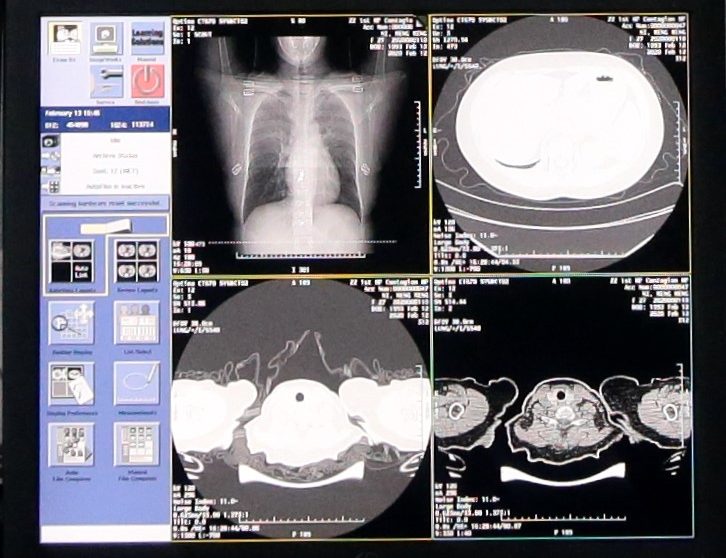Watch the webinar, Building a Real-Time Employee Health Solution with DataV, to learn how Alibaba Cloud is using DataV to cope with public health crisis by visualizing the health statuses of all its employee across the globe.

In early February, Alibaba Group's research and innovation institute DAMO Academy developed an AI-enabled system that could diagnose Covid-19 in 20 seconds with 96% accuracy.
The AI system identifies the novel virus through computed tomography scans of the chest. The algorithm has been trained with data and CT scans from more than 5,000 confirmed coronavirus cases so far and taps into deep learning to study patterns of infection.
We reached out to DAMO's AI-algorithm expert Xu Minfeng for a phone conversation about the artificial-intelligence tool and how it can help doctors during the health crisis.
On Feb. 4, almost two weeks into the lockdown of Wuhan, where the virus was first identified, the DAMO team started to train its algorithms for diagnosing coronavirus using diagnostic guidelines released by Dr. Shi Heshui, a leading radiologist from Tongji Medical College. Since the team had already been doing AI-enabled medical-imaging work for the past three years in fields such as common respiratory diseases, it took us a little under five days before producing the first set of calculations for Covid-19.
Our AI system does two things: One is to track treatment responses in confirmed cases, and the other is to provide diagnoses for suspected cases.
Hospitals in heavily affected regions like Wuhan might send us CT scans of the same, often confirmed case every two to three days and we'll use our AI system to detect signs of improvement, such as the reduction of white mass in the lungs.
Hospitals from regions surrounding the epicenter of the outbreak are tapping into the system's second function more frequently. They will send in scans of suspected cases to determine their chances of infection. The system classifies the results into confirmed coronavirus, the common flu, or other respiratory diseases.
Time and precision.
A CT machine typically has to produce 300 to 400 chest scans per patient to start the diagnosis of Covid-19. It would take even a very experienced doctor 10-15 minutes to go through such massive amounts of information, but trained AI systems can go through the scans in 20 to 30 seconds. Secondly, when we are dealing with a sudden and new viral outbreak, it's a daunting task to train every single medical practitioner out there on how to spot the virus, so the AI system is used to serve as an analytical, second opinion for doctors.
The challenge for adopting AI-driven systems or products is that the algorithms must be highly precise during the testing phase in order for them to gain practical adoption. If the system failed to yield accurate coronavirus diagnostics, we would lose doctor confidence immediately.
During the initial launch, our team had to react quickly to hospital feedback. For example, we had to make significant adjustments according to local conditions of Wuhan No. 6 Hospital, one of the first hospitals we worked with. Because this is a new strain of coronavirus, we are fine-tuning our algorithm as more studies are coming out, and we're also using feedback from medical staff working on the frontlines. So far, we have refined the system with 5,000 cases and counting.
Technically speaking, our continuous refinements have resulted in major improvements in diagnostic precision and speed. With the help of deep learning, our system can also fill in the gaps and provide additional diagnostic precision when there are not enough CT scans available. In terms of collaborations, our system is now being used by 26 hospitals in China and has helped diagnose over 30,000 cases. This breakthrough came because partners in both the public and private sectors joined together to push for the implementation of the AI system.
We will continue to work with partners like The First Affiliated Hospital of Medical School of Zhejiang University, Wanli Cloud, Chuangyuanjia, and Gupo Technology to bring our AI system onto the cloud. Medical practitioners can then directly upload CT scans using their smartphones or laptops to get instant results online. Other possibilities include shortened feedback cycles, where we implement survey features to collect direct feedback from medical practitioners to help improve our algorithm.
While continuing to wage war against the worldwide outbreak, Alibaba Cloud will play its part and will do all it can to help others in their battles with the coronavirus. Learn how we can support your business continuity at https://www.alibabacloud.com/campaign/supports-your-business-anytime
Originally posted at: https://www.alizila.com/how-damo-academys-ai-system-detects-coronavirus-cases/
How Alibaba Cloud E-commerce Solutions Empower Retailers in the Fight against Coronavirus
How Database Technology Powers Alibaba's Double 11 Global Shopping Festival

2,599 posts | 764 followers
FollowAlibaba Clouder - April 29, 2020
Alibaba Clouder - March 6, 2020
Alibaba Clouder - March 20, 2020
Alibaba Cloud Community - January 13, 2022
Alibaba Clouder - March 12, 2020
Alibaba Clouder - July 22, 2020

2,599 posts | 764 followers
Follow CT Image Analytics Solution
CT Image Analytics Solution
This technology can assist realizing quantitative analysis, speeding up CT image analytics, avoiding errors caused by fatigue and adjusting treatment plans in time.
Learn More Fight Coronavirus [COVID-19]
Fight Coronavirus [COVID-19]
Empowering businesses to fight against coronavirus through technology
Learn More Alibaba Cloud Academy
Alibaba Cloud Academy
Alibaba Cloud provides beginners and programmers with online course about cloud computing and big data certification including machine learning, Devops, big data analysis and networking.
Learn More Whole Genome Sequencing Analysis Solution
Whole Genome Sequencing Analysis Solution
This technology can accurately detect virus mutations and shorten the duration of genetic analysis of suspected cases from hours to just 30 minutes, greatly reducing the analysis time.
Learn MoreMore Posts by Alibaba Clouder